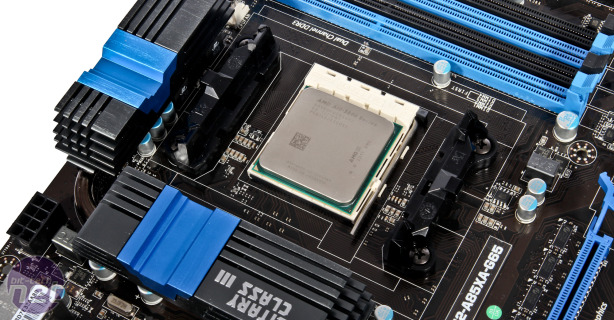
Performance Analysis
Interestingly, despite increases over previous generation APUs elsewhere, Cinebench and WPrime both exhibited slower results for the A10-5800K compared to the A8-3870K and even the A8-3850. We re-ran the benchmarks but got the same results and having corroborated our findings with those elsewhere, we have to conclude that the new architecture is the cause. Not that this is a bad thing - AMD's previous generation CPUs and APUs were well known for good performance in WPrime, even against the mighty Intel Core i5-3570K, which in other areas was far superior.
However, in the other benchmarks, the A10-5800K has a clear lead at stock speed. For example it was noticeably faster in the image editing and video encoding tests, beating the Core i3-2100 in the latter, while coming close in the multi-tasking test too, where it was miles ahead of the A8-3870K. Owners of the Phenom II X6 1100T Black Edition should take note too - the A10-5800K was snapping at its heals in the video encoding test and bettered it in the multi-tasking test. Overall, it came within 100 points of the Core i3-2100 - a far better result than the A8-3870K, while also making the more expensive FX-8120 look practically redundant.
In Left 4 Dead 2, there were significant gains to be had over the previous generation at 1,680 x 1,050 and some sizeable ones at 1,280 x 720 too. Unfortunately we didn't have time to re-test all the other CPUs at 1,920 x 1,080 but the A10-5800K managed a minimum frame rate of 47fps, giving it plenty of headroom should you want to whack the AA up or play a more demanding game.
Click to enlarge
Memory testing and overclocking
We also dropped in a couple of 2,133MHz 4GB DIMMs to see what impact this had on gaming performance by providing the GPU with a little boost in memory speed. This saw a seven per cent boost in the minimum frame rate in Left 4 Dead 2, which did more for performance than our overclocking. We'll be taking a look at this in more detail soon, but with 2,133MHz 8GB sets retailing for around £12 more than 1,600MHz flavours, it might just be worth the investment.
We managed to overclock the A10-5800K to 4.4GHz using a vcore of 1.5V, and also increased the GPU boost to 844MHz. Not great results, but we may re-visit this area to spend more time tweaking the settings. Ironically, this saw the biggest gains in WPrime and Cinebench - benchmarks that the A10-5800K wasn't particularly adept at in the first place. Even so, it leapfrogged the Core i3-2100 in WPrime, and saw a 10 per cent jump in the Cinebench score, resulting in a four-place gain. Power consumption was lower than all the other CPUs on test, bar the Core i3-2100.
Conclusion
Perhaps the key point to take away from our findings is that, while the unequivocal recommendation of the A10-5800K isn't going to find its way into this review, AMD has done exactly what it needed to do following the success of Llano. Trinity is much better in games while consuming less power, and is generally significantly faster elsewhere too. More importantly, it seems to have learned some valuable lessons from the graphics card market in pricing its products as keenly as possible. The 7000-series cards are currently winning in practically every price point, and AMD has both filled shelves with its new APUs and hit the nail on the head with pricing, which should give Intel something to think about for the time being.
Outside of games, there's still the issue of low-end Core-i3s and even Pentiums giving the A10-5800K a bloody nose in the odd benchmark - Trinty can still struggle in our image editing benchmark, although it finally holds its own when it comes to our video editing and multi-tasking tests, which is very encouraging. Trinity is far from a Core i5-beater though. Yes it might have a huge lead in games when compared to the HD 4000 graphics of the Core i5-3570K, but that kind of comparison isn't one that sits well with us, especially given the Intel CPU's utter dominance elsewhere.
Intel also has the advantage when it comes to making a choice, especially if you're not planning on building a gaming-focussed PC. LGA1155 has a far better upgrade path in that the current Pentium and Core-i3 line-up are the bottom of the pile. Should you need more horsepower in a year or two, you could sell your Core i3 and get a Core i5-3570. With Socket FM2, the A10-5800K is as fast as it gets, and AMD is only looking at adding one more generation.
If you don't plan on upgrading the system for a while, and just want a good value way to play games at half decent settings (even better settings if you're not talking about the likes of Battlefield 3) then Socket FM2 begins to make more sense. The bad news is that Trinity is still limited to a rather niche area - good frame rates for around £100 and performance that doesn't suck at everything else. The good news is the A10-5800K fits that niche perfectly.

-
Value33 / 35
-
Features14 / 15
-
Speed34 / 50


MSI MPG Velox 100R Chassis Review
October 14 2021 | 15:04









Want to comment? Please log in.